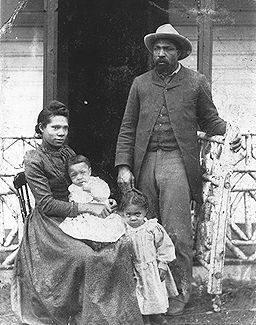John Ware (cowboy) facts for kids
Quick facts for kids
John Ware
|
|
|---|---|

John Ware and Family, c. 1897
|
|
| Born | 1845 |
| Died | September 11, 1905 (aged 59–60) |
| Occupation | rancher, cowboy |
| Spouse(s) | Mildred Lewis |
John Ware (c. 1845 – 11 September 1905) was a famous Canadian cowboy. He helped start the important ranching business in Southern Alberta. People remembered him for being excellent with horses. He was one of the first ranchers in Alberta. John Ware arrived in 1882 and ranched until he died in 1905.
Contents
John Ware's Early Life
John Ware was born into slavery. We do not have a record of his exact birth date or place. Some historians think he was born in Georgetown, South Carolina. Others believe he was born in Tennessee.
After the American Civil War ended, John Ware moved to Texas. There, he learned how to be a rancher and became a skilled cowboy. He then worked his way north, moving cattle from Texas to Montana.
Becoming a Rancher in Alberta
In 1882, John Ware got a job helping to move 3,000 cattle. These cattle came from the United States to Sir Hugh Allan’s North-West Cattle Co. in Alberta. After delivering the cattle near Calgary, he found work at the Bar U Ranch and Quorn ranches.
Later, he started his own ranch. It was located near the Red Deer River. By 1900, he and his wife, Mildred Lewis, had five children.
Life and Challenges
John Ware moved his family from the Calgary Region to a new spot. This was northeast of the village of Duchess, Alberta. In 1902, a big spring flood destroyed his first home. He then rebuilt his home on higher ground. This new home overlooked a stream, which is now called Ware Creek.
In the spring of 1905, Mildred died from pneumonia. Just a few months later, John Ware also died. Even though he was a master horseman, his horse tripped in a badger hole, which caused his death. His funeral was one of the biggest in early Calgary.
A Legendary Cowboy
Like many folk heroes, many stories are told about John Ware. People shared tales about his amazing ability to eat, ride, and shoot. These stories helped create the cowboy legends of that time.
It is said that he was never thrown off a wild horse. People also say he helped make steer wrestling popular. This event later became a highlight of the Calgary Stampede. John Ware was a remarkable person. He helped build the ranching industry in Western Canada. At the same time, he showed that stereotypes were wrong. He became one of the most respected people on the Alberta frontier. John Ware is still an important part of Alberta history.
John Ware's Legacy
Many things are named after John Ware and his family. These names honor his contributions to Alberta.
Places Named for John Ware
Several natural places near the Wares' ranch are named after them:
- John Ware Ridge
- Mount Ware
- Ware Creek
Buildings and Organizations
Other places and groups are also named in his honor:
- "John Ware Junior High School" in southwest Calgary.
- The John Ware building at Calgary's Southern Alberta Institute of Technology (SAIT). SAIT is a college for technical studies.
- The John Ware 4-H Beef Club in Duchess, Alberta.
Preserving His History
In 1958, John Ware's log cabin was moved. This was the family home from 1900 to 1905. It was moved from near Millicent, Alberta, to Dinosaur Provincial Park. The cabin was fixed up and opened again in 2002.
A musician from Alberta, Diamond Joe White, released a song. It is called "High Rider: The John Ware Story."
In 2006, a small piece of wood from the cabin was used in the Six String Nation project. This piece is now part of Voyageur. This is a special guitar that is central to the project.
In 2012, Canada Post released a special stamp. It featured John Ware to celebrate Black History Month.
In 2020, a documentary film was made about him. It is called John Ware Reclaimed by Cheryl Foggo.
In 2022, the Government of Canada recognized John Ware. He was named a Person of National Historic Significance. This means he is an important part of Canada's history.

